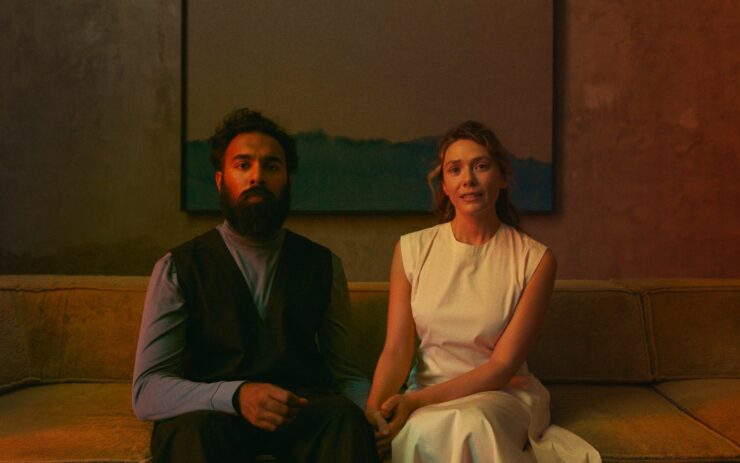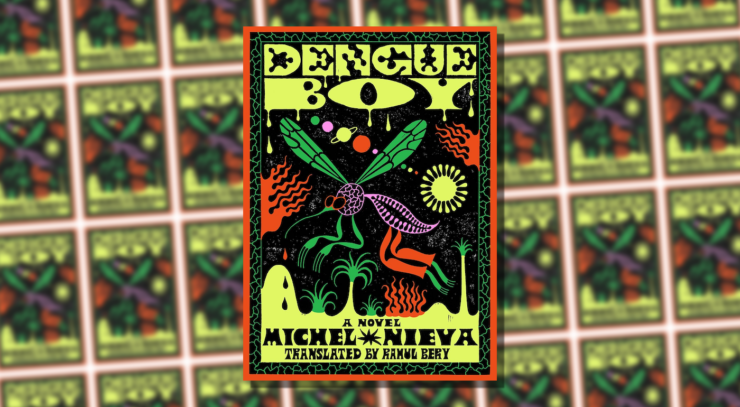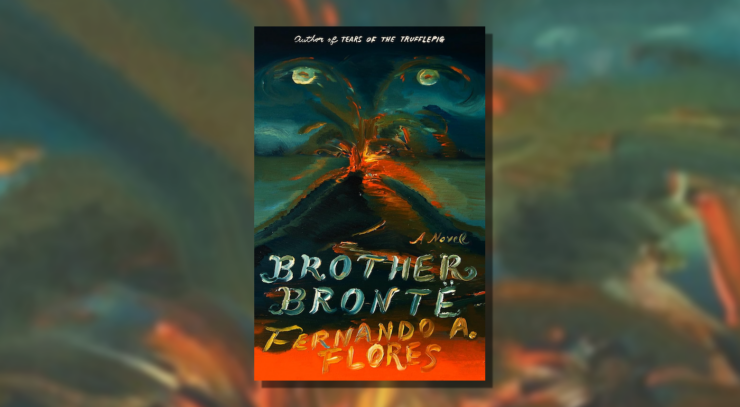This spring, the fashion house Balenciaga launched its latest line with a fictional news broadcast from dystopia. Repurposing the uncanny valley as virtual runway, the video features prosthetically altered models with blackened mouths speaking in electronic blurts over a grim techno soundtrack, pantomiming headlines from a world of disappearing water, robot control, and planets realigning—all while wearing austerely futuristic new couture apparently designed to aesthetically summon this grim tomorrow into being, as the conceptual chyron crawl scrolls enigmatic koans like “In space humans cannot cry,” “Mushrooms have thousands of genders,” and (perhaps grimmest of all) “It’s always Fashion Week somewhere.” While it may not make you want to buy the clothes, it provides another remarkable example of people explaining what it feels like to be alive right now through reference to our darkest science fictions.
You don’t need to trawl avant-fashion shows to find it—just check your news feed.
As I write this, a search of The Washington Post reveals three headlines from the past week describing the day’s events as “dystopian.” From Tucker Carlson’s histrionic fear-mongering about the anarchic mobs of his “American Dystopia” to the laments of The Guardian’s post-pandemic cricket writers covering matches without spectators, the d-word is routinely used by journalists across the political gamut—usually as grim foreboding, sometimes as gallows humor. NBC News reporter Ben Collins even proclaims that he is working the “dystopia beat.” When they say it, you know just what they mean. Even as you can’t help but wonder whether, in their invocation of Orwellian analogies, our pundits and reporters are doing exactly what Orwell warned against—obfuscating the real truth with imprecise language, and thereby helping to usher the real dystopia into being.
The blurring of the boundary between dystopian fiction and the evening news is not so new. It goes back to at least 2017, when White House talk of “alternative facts” put Orwell’s 1984 back atop the bestseller lists—driving sales of that 70-year-old masterpiece up 10,000 percent in the week following the inauguration. Hulu’s adaptation of Margaret Atwood’s The Handmaid’s Tale and Amazon’s take on Philip K. Dick’s The Man in the High Castle delivered authoritarian alt-Americas whose underground resistance movements seemed equally aimed at the real-life regime. Publishing began a wave of new novels that imagined a Second Civil War, including Omar El Akkad’s American War and my Tropic of Kansas (followed in 2018 by books like Lilith Saintcrow’s Afterwar and Claire O’Dell’s A Study in Honor, and in 2019 by Craig DiLouie’s Our War and my Rule of Capture)—just as our partisan divisions began to make it seem like such a conflict was about to erupt in real life. The gun lobby launched a series of ads that looked like trailers for those books, narrating fiery news clips with a dark vision of the self-proclaimed “Resistance” as revolutionary “saboteurs” seeking to “drive their daggers through the heart of our future…so they can build their utopia from the ashes of what they burned down.” A vision so extreme it seemed like parody, until a few weeks later when similar scenes erupted on the streets of Charlottesville—complete with brownshirts in white polos—and real people died in the conflict.
Flash forward to 2020, and the scenes on the news look more dystopian than the darkest new Hollywood futures streaming to our living rooms. The fear factor gets dialed up every day, fueled by genuine concerns about everything from contagion to climate crisis to the coming political reckoning, but amplified by an overclocked media environment that profits from its ability to stoke our anxieties. And those of us who craft even darker futures in our fictions are forced to wonder whether we might be contributing to the problem, cranking out the memetic fuel that lets a clickbait-driven culture turn up the algorithmic volume in a way that summons its own most hysterical fears into being.
“I blame science fiction dystopias,” jokes cyberpunk progenitor Bruce Sterling in a popular running gag on his Twitter feed. It’s funny because it uses the platform’s own exclamatory tendencies to riff on the way such narratives distract from the very real problems driving the state of the world. But it’s also funny because it tells the truth, especially about the way our most dismal narratives can excuse or encourage our failure to take agency over our own futures.
As a writer, it’s an uncomfortable feeling when the parallels between the evening news and your deliberately provocative worldbuilding make you feel like someone is taking your books and using them as manuals. The similarities are there. Science fiction has a knack for drawing out the immanent now, using a fun-house mirror to show what it really feels like to be alive in the current moment—an oblique realism that often passes for prescience when it mostly just magnifies emergent aspects of the observed world. The dystopian lens is a useful tool to shatter exceptionalist myths and amplify what’s wrong with the real world, all while telling compelling stories. But when its dramatic devices are imported into the day’s headlines, it distorts the truth, achieving an effect like those chumbox ads that stroke our darkest fears and creepiest curiosities. In fiction and in real life, overreliance on dystopian framing reflects a failure to imagine futures we would actually want to live in.
One reason the real world feels yoked to our dystopian imagination may be the failure of other science fictional futures to deliver the goods. The techno-utopian Tomorrowland 20th century science fiction promised us this century would bring turned out to be something much darker. Real life never lives up to the movie version our popular culture and politics teach us to expect. The “End of History” and the birth of the World Wide Web promised us a cyber-utopia of peace, progress and prosperity just around the corner, but the first two decades of the 21st century delivered a very different story, from 9/11 and its dark aftermath to the financial crisis and the resurgence of ethno-nationalism. Now our response to the pandemic has the world looking at the U.S. as a declining nation with some of the characteristics of a failed state. You can’t blame science fiction dystopias for all that, any more than you can blame the mirror for how you look in the morning.
Dystopia is the kind of science fiction you can expect when the whole world seems unable to get a handle on what tomorrow will bring, let alone “the future.” It is a powerful form, with the capacity to draw on the worst of human history to highlight the injustices of the present. At its best, it is a fiction of resistance. Tiny acts of courageous dissidence by horrifically oppressed characters are what enable us to endure stories as grim as The Handmaid’s Tale and 1984, providing flickers of hope. Writing Tropic of Kansas, I learned I had to dial up the worst injustices of contemporary American life in order to plausibly conjure the positive revolutionary change that was my real goal. Dystopian storytelling has the greatest power when it births a vision of utopian possibility that gives real meaning to the struggle. Fighting the Empire is great, but what comes after the Ewok party?
Science fiction has produced many plausible but compromised utopias, usually by putting them in tension with equally plausible dystopias. Consider masterworks like Ursula K. Le Guin’s The Dispossessed, Kim Stanley Robinson’s Pacific Edge and Green Mars, Joanna Russ’s The Female Man, and Octavia Butler’s Earthseed books. But there are far fewer such books than there are popular dystopias, especially in recent years. Part of that has to do with the narrative challenges of writing stories set in places where conflict is minimal, or where the novelistic preoccupation with self has been replaced by a focus on community as protagonist. But science fiction has unique tools to tackle such challenges, and has already done an amazing job lately of showing its capacity for imagining more inclusive futures. As pandemic compounds political uncertainty and climate angst to further confound our ability to get a bead on the present, SF has an opportunity to provide fresh visions of what could lie on the other side, and help us stop doomscrolling our way through this dystopian Groundhog Day. We might even make the future feel like the Future again.















“One reason the real world feels yoked to our dystopian imagination may be the failure of other science fictional futures to deliver the goods.”
Heck, Dave Barry has an occasional blog entries titled “We Were Promised Flying Cars” on things like chicken free chicken and poo vaporizing toilets.